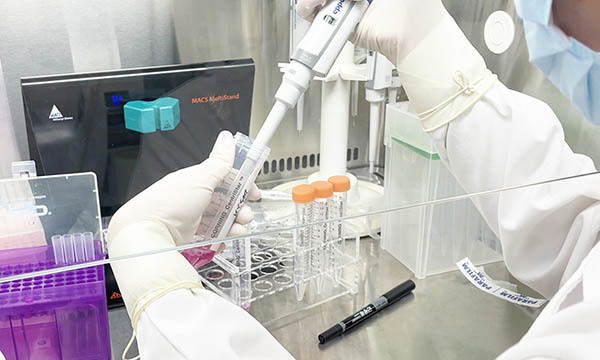
HUAREN MEDICAL TECHNOLOGY
R & D SERVICES
Basic Scientific Research
Basic Scientific Research

Sequencing Analysis Services


• Sequencing Analysis Services
10xGenomics Single Cell Transcriptome Sequencing
High-throughput gene expression profiling at the single-cell level, in-depth analysis of complex cell populations, characterizing the expression profiles of individual cells; CRISPR interference, cell surface proteins can be detected simultaneously, avoiding the heterogeneous biological information of individual cells to be masked by the homogenization of a large number of cells.

• Genome-Level Research Services
Sequencing for microbial population identification (16S/18S/ITS)
The number of microorganisms in nature is as large as the sands of the Ganges, and most of them cannot be observed in laboratory culture. The number of known microbial species has exceeded 100,000, and this is still a rapidly expanding number. DNA sequencing has been proven to be more accurate and faster than traditional biochemical and phenotyping methods, and can be used for all strains of microorganisms, regardless of the characteristics of the strains themselves. With advanced sequencing instruments and years of microbiological testing experience, we can provide you with fast, efficient and authoritative microbiological testing services, including bacterial 16SrDNA sequencing, fungal 18SrDNA sequencing and ITS sequencing.

• Transcriptome Sequencing Research Services
lncRNA sequencing
Long-noncoding RNA (lncRNA) is an RNA molecule with a length between 200 and 100,000 nt that does not have a protein-coding function. They exist in both polyA-tailed and non-polyA-tailed forms, and are characterized by low cross-species conservation, tissue-specific expression, and low abundance. lncRNAs are much more diverse than coding RNAs, and it is conservatively estimated that 4%-9% of mammalian genome sequences produce lncRNA transcripts, whereas the proportion of the corresponding protein-coding RNAs is only 1%-5%. Current research suggests that lncRNAs are involved in transcriptional regulation, post-transcriptional regulation, protein transport and mRNA degradation. lncRNAs have become a hot spot in the field of non-coding RNA research, and with the help of high-throughput sequencing, researchers are able to rapidly obtain lncRNAs related to diseases or specific biological processes and conduct in-depth studies.


smallRNA sequencing
SmallRNAs are important regulators of life activities and play an important role in the regulation of gene expression, biological development, metabolism and disease occurrence and other physiological processes, including miRNAs, piRNAs and siRNAs.
Cyclic RNA sequencing
Cyclic RNA sequencing is an emerging transcriptome sequencing technology. In the past, it was generally recognized that non-coding RNAs in cells existed mostly in linear form. In recent years, more and more studies have found that the expression of cyclic RNAs in mammalian cells is much higher than the generally recognized level. Cyclic RNAs can participate in the regulation of gene expression, such as closing the role of miRNAs and regulating the expression of homeodomain genes, which is a new research hotspot in the study of long-chain non-coding RNAs.

• Epigenetics Research Services
Researchers can use MeDIP-Seq and hMeDIP-Seq technologies to quickly and efficiently search for methylated regions on the genome, thereby comparing differences in DNA methylation modification patterns between different cells, tissues, or disease samples, and providing theoretical evidence for biological studies or clinically applied protocols.
MeDIP methylation sequencing
 MeDIP-Seq (Methylated DNA Immunoprecipitation Sequencing) sequencing is a genome-wide methylation detection technology based on the principle of antibody enrichment for sequencing, using methylated DNA immunoprecipitation technology, through the 5'-methylcytosine (5mC) antibody specific enrichment of genome on the occurrence of methylation of the DNA fragments, and then through the high-throughput sequencing can be carried out at the genome-wide level of the high-precision study of the CpG-dense hyper-methylated regions.
MeDIP-Seq (Methylated DNA Immunoprecipitation Sequencing) sequencing is a genome-wide methylation detection technology based on the principle of antibody enrichment for sequencing, using methylated DNA immunoprecipitation technology, through the 5'-methylcytosine (5mC) antibody specific enrichment of genome on the occurrence of methylation of the DNA fragments, and then through the high-throughput sequencing can be carried out at the genome-wide level of the high-precision study of the CpG-dense hyper-methylated regions.
hMeDIP-Seq (hydroxymethylcytosineDNAImmunoprecipitationSequencing) sequencing is based on the same principle as MeDIP-Seq. 5'-Hydroxymethylcytosine (5hmC) antibody is used to specifically enrich for methylated DNA fragments on the genome. 5hmC is a newly discovered modifier base produced by the 10-11 translocation (TET) family of enzymes through oxidation. 5hmC is a newly discovered modifier base produced by the 10-11 translocation (TET) family of enzymes through the oxidation of 5mC. 5hmC not only reduces the affinity of the methylation-binding domain (MBD) of MeCP proteins for methylated DNA, which is potentially involved in the transcriptional regulation of gene expression, but also participates in the process of DNA demethylation.
Researchers can use MeDIP-Seq and hMeDIP-Seq technologies to quickly and efficiently search for methylated regions on the genome, thereby comparing differences in DNA methylation modification patterns between different cells, tissues, or disease samples, and providing theoretical evidence for biological studies or clinically applied protocols.
 mRNA methylation sequencing
mRNA methylation sequencing
Epigenetic modifications occur not only at the genomic level (DNA methylation), but likewise at the transcriptomic level and have important post-transcriptional regulatory functions therein. As early as forty years ago, it was discovered that there is a methylation modification on adenine (m6A) on messenger RNA. This m6A modification is very prevalent, occurring at a frequency of about 3-5 residues/mRNA. m6A methylation modification is reversible and probably dynamically regulated. m6A methylation and demethylation is regulated by the methylase complexes METLE3, METLE14, WTAP and the demethylase FTO. m6A is very well conserved in the human and mouse transcriptomes, suggesting that this modification is likely to have important functions. m6A is associated with mRNA shearing, biological clock regulation, and mRNA stability. Furthermore, m6A induces mRNA translocation from the translating ribosome to the cytoplasmic P-body by recruiting YTHDF2, where it is degraded. And the degree of mRNA degradation is related to its methylation site number.
For the detection of mRNA methylation, the method of methylated mRNA enrichment combined with high-throughput sequencing (MeRIP-Seq, m6A-specific methylated RNA immunoprecipitation with next generation sequencing) is currently used. The principle of MeRIP-Seq is that since mRNA methylation generally occurs at the 6th nitrogen atom of adenine in mammals, the highly methylated mRNA fragments can be enriched by specifically conjugating the m6A antibody, and sequenced in combination with second-generation high-throughput sequencing to detect the methylation sites in the whole transcriptome.


